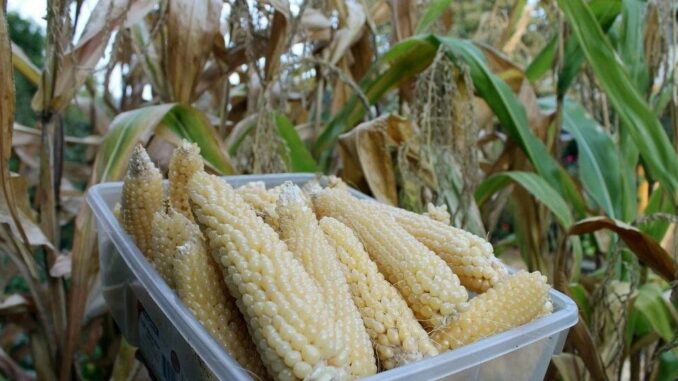
Sweet corn harvested fresh from the home garden and cooked soon afterward is one of life’s great treats. If you have never had that experience, now is the time to plant sweet corn in the garden.
Sweet corn plants are large, and they occupy a good amount of space. As a result, many vegetable gardeners don’t plant corn. Each plant only produces about two ears of corn, so overall production is not as high as it would be for other popular vegetables like tomatoes, squash, peppers, or trellised cucumbers. But if you have room, growing sweet corn is fairly easy and the results are delicious.
Types to grow
Corn is harvested over a relatively short period as all of the ears ripen at about the same time. If you have room, you can extend the harvest season by planting seeds every two to three weeks through April. You may also plant early, midseason and late-season varieties.
There are several different types of sweet corn. Standard sugary sweet corn varieties like Merit (yellow), Silver Queen (white), and Sweet G90 (bicolor) differ from field or grain corn in that kernels produce more sugar and less starch. They are also creamier.
A disadvantage of sugary corn is that while it’s sweet at the time of picking, it loses its sweetness quickly after harvest as sugar is converted into starch. Tthat’s why homegrown sweet corn cooked shortly after harvest is so sweet and delicious.
A corn plant sprouts on Ray McCormick’s land in Vincennes, Ind., in May 2021. (Photo by Robert Scheer, Indianapolis Star)
Sugary-enhanced sweet corn varieties have higher sugar levels. Even though sugar is still converted into starch after harvest, sugary enhanced varieties have a higher sugar content for a longer time than regular sugary varieties do. Sugary-enhanced varieties include Ambrosia (bicolor), Argent (white), Avalon (white), Bodacious (yellow), Incredible (yellow), Miracle (yellow), Precious Gem (bicolor) and Temptation (bicolor).
Supersweet sweet corn varieties have very high sugar levels, and this sugar is not converted to starch as quickly after harvest as it is in sugary and sugary-enhanced corn. However, supersweet corn has a less creamy texture. Supersweet varieties include Cameo (bicolor), Honey N’ Pearl (bicolor) and Ice Queen (white). There are also some varieties that combine two or all of these genotypes. Honey Select (yellow) is one example.

Leave a Reply